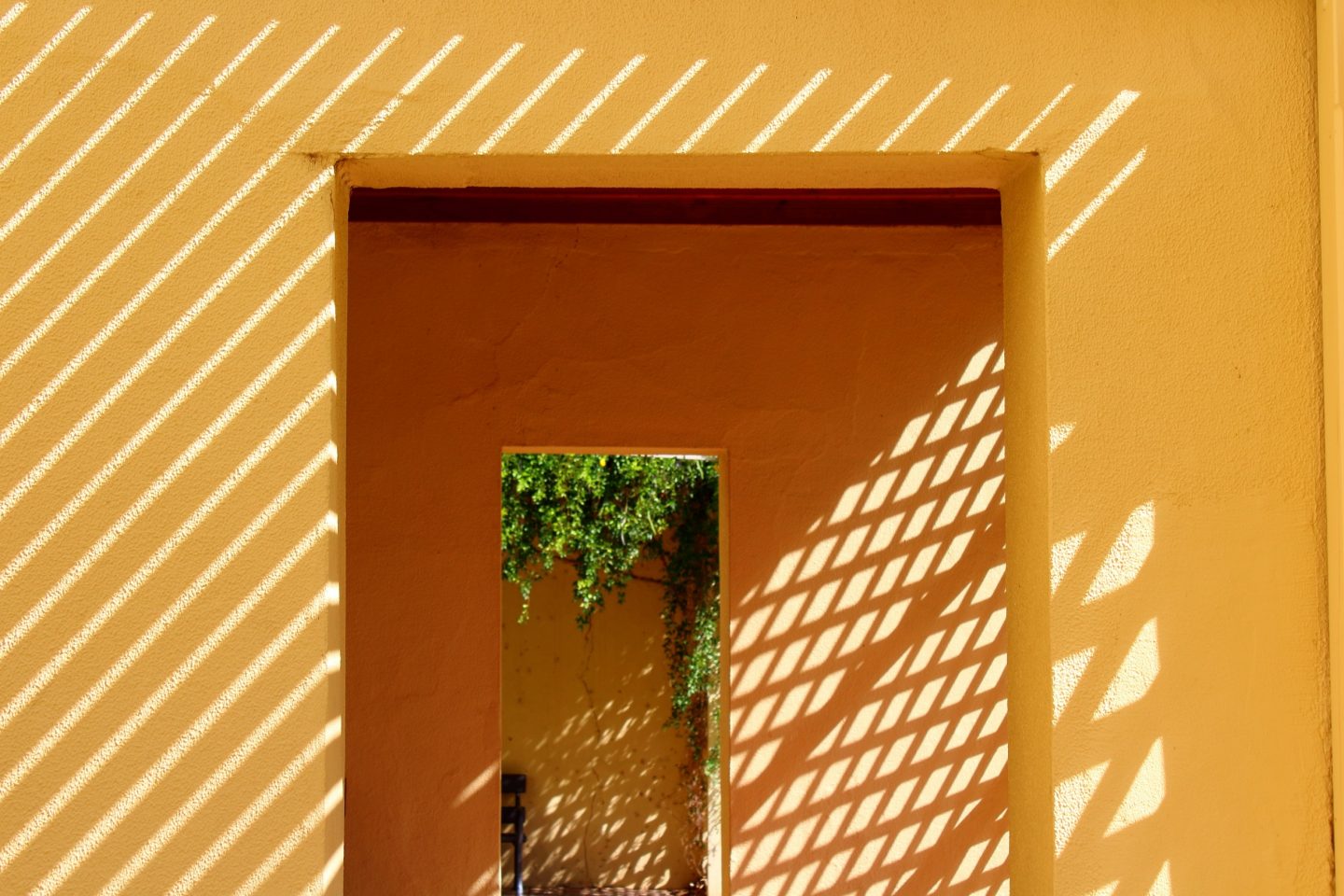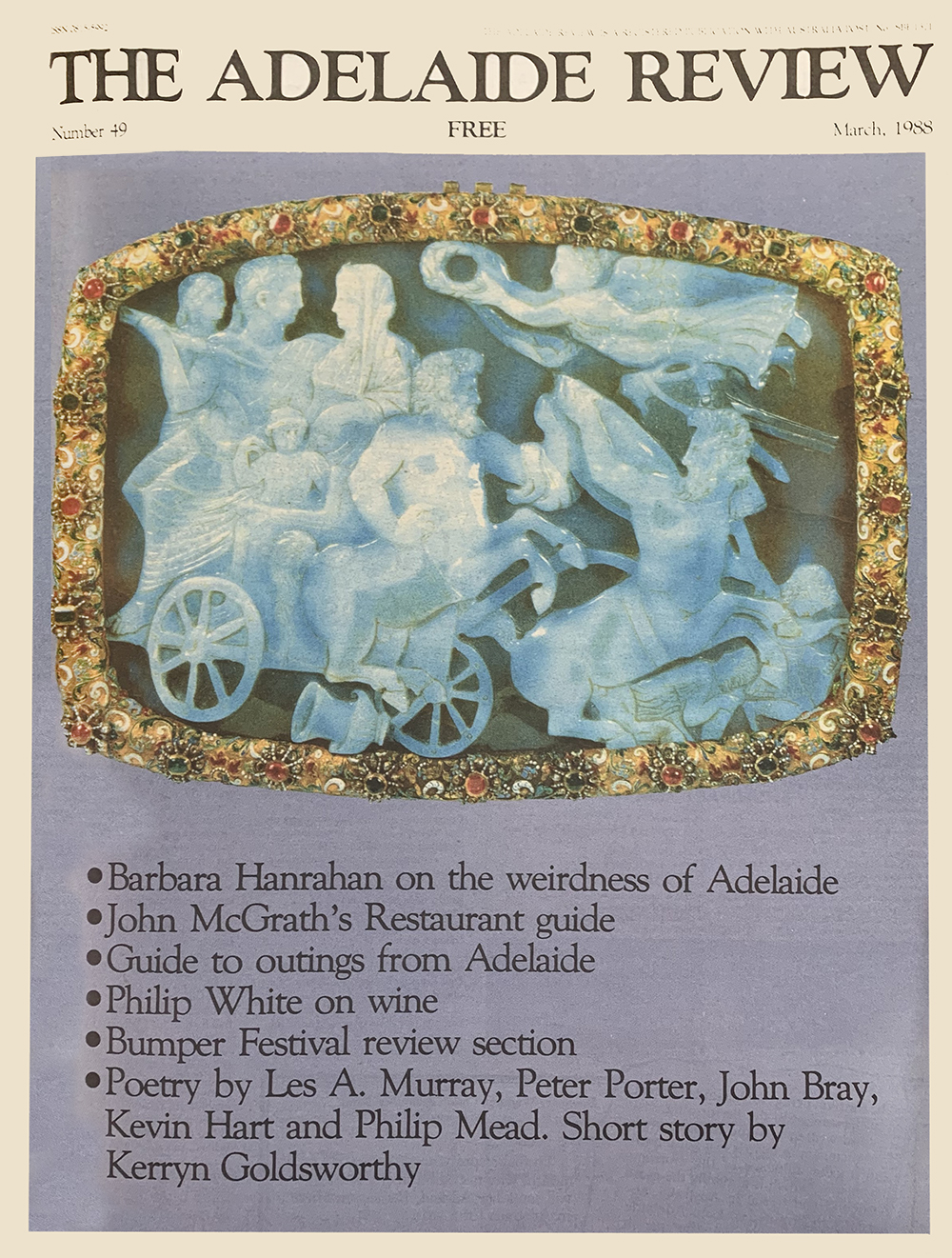Reflections on 'Weird Adelaide'

In the March 1988 issue of The Adelaide Review, Barbara Hanrahan penned a timely reflection on the darkness, light and distinct ‘weirdness’ of our southern capital. Three decades later, writer Tracy Crisp is still thinking about it.
I went to my first Writers’ Week session in 1988, the year Barbara Hanrahan’s ‘Weird Adelaide’ piece was published in The Adelaide Review. I went to that Writers’ Week in the same way I had done nearly everything since arriving from Port Pirie in 1986: I snuck in at the last minute, found a seat at the back, watched the people I recognised greet each other, then snuck away just before the session finished as if I had somewhere to be, all the while aching to be a part of, not apart from.
I don’t remember reading ‘Weird Adelaide’ then, but I probably did. During those early years, I was trying to understand Adelaide from the outside in. It would be years before I read Salman Rushdie’s words, “Adelaide was an enigma, and I was getting interested in cracking its codes,” but in those years that’s exactly what I was trying to do. Noticing everything, reading everything from The Adelaide Review to the gossip pages of The Advertiser to past editions of On Dit. When I should have been reading texts explaining fiscal policy, I sat in the stacks of the Barr Smith Library connecting the dots between names and places, creating my own internal Adelaide map.
I was trying to find a way to understand this city, to find a way in. I had no choice, I had to crack the code. For a young woman from regional South Australia, there was no other destination. I had to work out how to fit.
If I did read ‘Weird Adelaide’ that year, I would have seen Barbara Hanrahan as Adelaide establishment. How could she not be? She had the authority to publish work seeking to give definition to the city. What was more establishment than that? I would have agreed with her evocations of the weird, the shades of noir, but I would not have seen them as something particularly Adelaide. Having grown up in a country town, being creepy was not what separated Adelaide from other cities. It was what separated cities from country towns.
Barbara Hanrahan left Adelaide and went to London “…because [she] wanted to be an artist, and because it was the easiest way to escape Adelaide and a world where they always asked you what school you’d gone to”. But I left Adelaide thinking it would help me become more Adelaide. If I travelled, I would be more interesting, more worldly. My opinions would matter more, I would be more employable, more knowable.
While I was away, I came to understand that Adelaide is not the glittering metropolis I had believed it to be. On the South-East Asia backpacker’s trail, it seemed that everyone knew more about Australia than I did. I’d been to Melbourne once and Sydney twice, but every backpacker I met had lived in these strange cities and if they registered Adelaide at all it was only as somewhere that was too far, too boring to make the effort. “You sound like you’re from New Zealand,” they said. Barbara Hanrahan writes about the paradox of writing about Adelaide from a distance: “ … Adelaide is the place that gives me all the ideas for the work, even if I’m writing something set in London… But sometimes it’s harder to see Adelaide when you’re there.” It is true that you see a place differently once you’re not living in it and that distance brings new perspectives, but I have never seen Adelaide as clearly as I did in the years before I left for Abu Dhabi. These were the final years of my father’s life as well as the final years of my children’s preschool years. Living in such simultaneous proximity to death and to the wonder of childhood meant that I felt Adelaide – by which I mean I could feel Adelaide’s rhythms, its smells, its sounds, its tastes and, at the same time, I felt a sense of not only belonging, but of being anchored in time and in place.

This was when I really began to explore Barbara Hanrahan’s work. I read ‘Weird Adelaide’ as part of some research I was doing at the time, and that led me to The Scent of Eucalyptus, a book which resonated with me in a way that few books have done since I was a child. It sparked an interest not only in Barbara Hanrahan’s work, but in her life.
As I read about Barbara Hanrahan’s Adelaide, I began to take my children on trips to explore the places she described. The Museum, the Botanic Gardens, the Zoo. I had been to these places before, of course, but I looked now for the details she had described, scribbling notes in my journal and taking countless photographs on my new digital camera. I layered these visits with other places I wanted my children to know – the Aboriginal flag in Tarntanyangga, the Gepps Cross drive-in, Centennial Hall.
A few months after my father died, we made an unexpected, unplanned move to Abu Dhabi and there my writing career – which was only embryonic at best – came to a standstill. There were many reasons underlying this, but one of the most significant was that I felt entirely unrooted (on top of my move from Adelaide to Abu Dhabi, we had sold my childhood home in Port Pirie). Unlike Barbara Hanrahan’s experience, the physical distance took away from me the deep connection that I needed to write with any meaning.
But my fascination with ‘Weird Adelaide’ continued, and on visits home, I continued to scribble notes, and to take my children to Adelaide places. Lasagne at Lucia’s, the rockpools at Hallett Cove, a walk across the causeway to Granite Island. At the back of my mind, I was still trying to find a way to make a ‘Weird Adelaide’ project come to life.
A year or so after I returned from a seven-year stay in Abu Dhabi, Caren Florance, a Canberra-based friend I had made online, asked me whether I would collaborate with her on a project. She’d been invited by an Adelaide printmaker, Simone Tippett, to be part of a project called Collaborative Variations, and needed a South Australian partner. I’d never worked in this way before, but the insight into the visual arts and printmaking worlds helped me see a new way that ‘Weird Adelaide’ might work. I asked Caren whether she would be interested in designing and printing some short stories that I would exhibit, and she suggested that I ask Simone and other printmakers to make their own Barbara Hanrahan-inspired prints. “Seriously,” she said, “Printmakers love this kind of thing.”
I asked Jo Harris at Mrs Harris’ Shop whether she would be interested in hosting the show in her gallery. When she said yes, I had all of the pieces of the ‘Weird Adelaide’ puzzle. And then, as with so many of this year’s best-laid plans, COVID-19 happened.
My initial disappointment at postponing the show has faded, and instead I have returned to the pieces I wrote, seeing new possibilities. This time of isolation, of shrinking into our locations, has forced me to look at my immediate surroundings with a renewed intimacy. Not only with a focus on the details, but with a fondness for them too. Bringing my attention to Adelaide makes even more sense than ever before.
As the immediate crisis lessens and we start to imagine what the world might look like, it is likely that travel will be restricted, and that we will be living local lives for some time to come. When I first returned to Adelaide four years ago and my partner still lived in Abu Dhabi, I would walk along The Esplanade and take great comfort in the planes flying in and out over the gulf. It reminded me that the world was small and that our connections would not be lost. I used to listen for the final flights of the night, knowing that they were going to Qatar or Dubai, the thread that connected us. I thought I would miss those planes, I feel that I should, but I don’t. Not yet, anyway. Rather I feel a softness in their place, a reminder to look at the place where I am.
It reminds me of the way I felt during those years of my father’s dying. But there is one significant difference. When you are with a person who is dying, you look up and realise that the world has been going on without you, that you have been in a world and a time of your own. Now, though, I step outside and I feel myself surrounded by people, all blinking in the light, all trying to make sense of things.
I cannot imagine what Barbara Hanrahan would have made of these times, how she would have seen them, written them, printed them. If anything, Adelaide is now less weird than it has ever been. Who knows how the virus will continue to affect South Australia, and what kind of city will emerge out of the crisis?
But as I write, the final words of the original piece continue to ring true:
“What we want now in Adelaide are writers and artists who work from the heart of those commonplace suburban streets, who recognise the weirdness of the ordinary, who record it before the version of it we have now is swept away. We want passion and intensity, an art that comes from places like Port Adelaide and Thebarton and Holden Hill; that stays unofficially weird.“